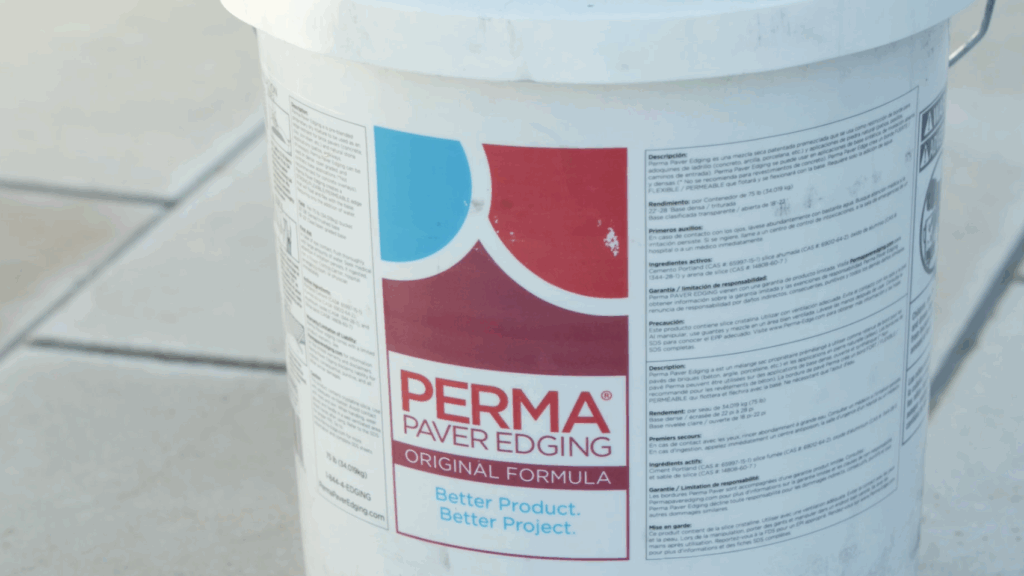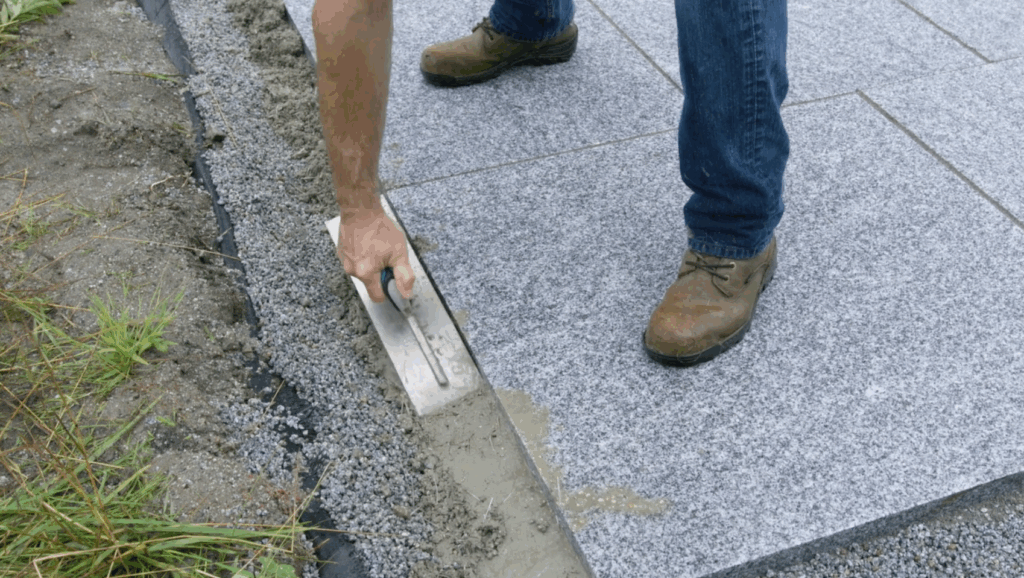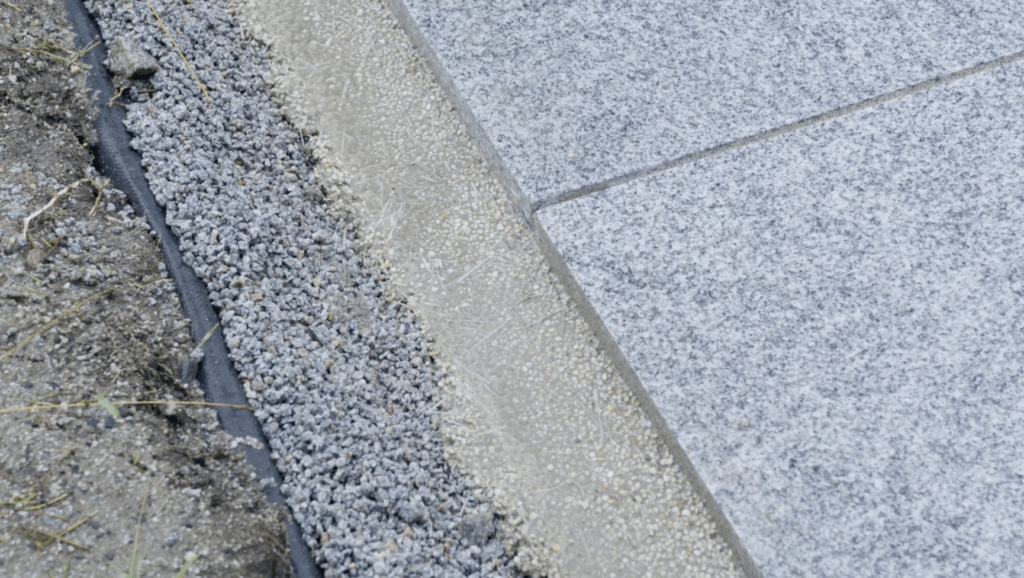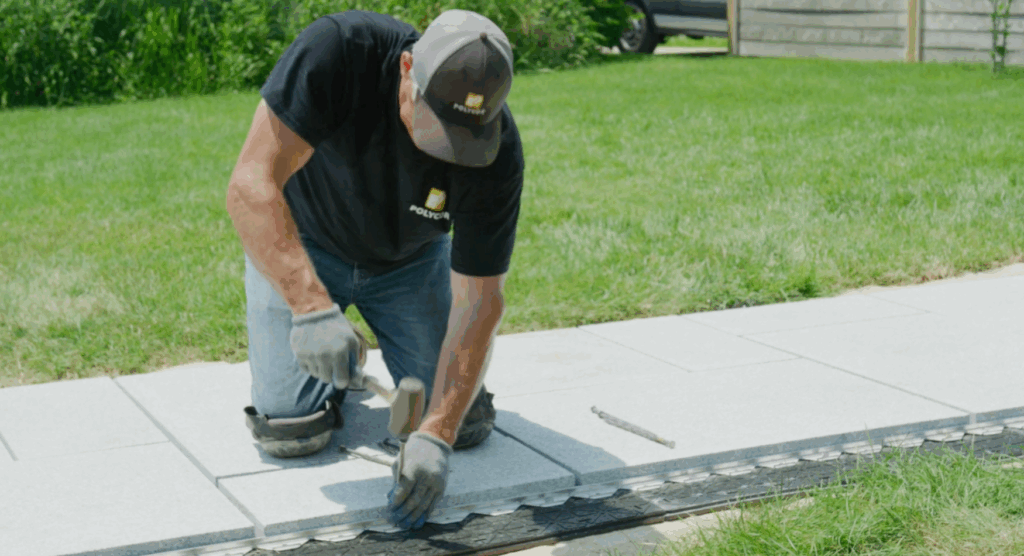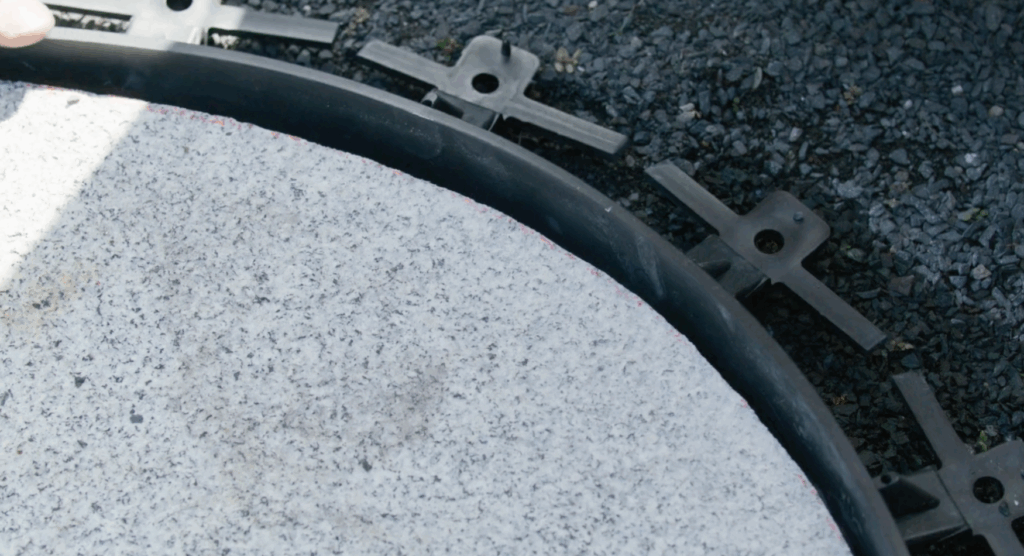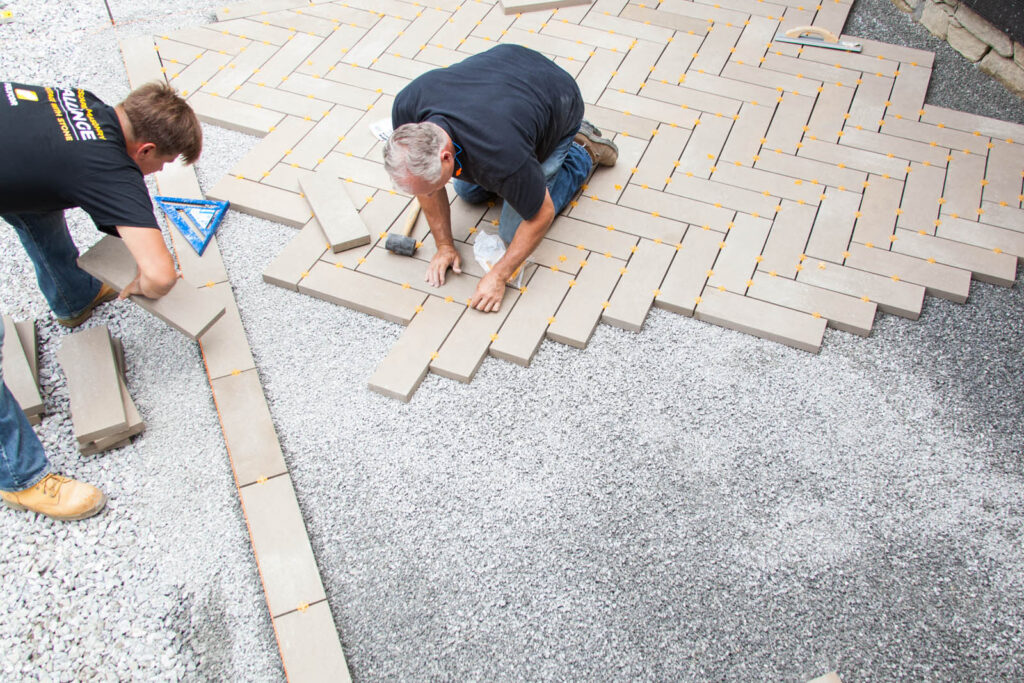
Polycor U
Edge Restraints: The Differences, Pros and Cons
This course explains the different types of edging products and how they perform for various applications.
Are you stuck trying to decide which edging product is best for your walkway or patio project? Look no further because in this course we break down the differences between metal, plastic and fiber-reinforced, polymer-modified concrete edge products – how to use them and where they work best. Don’t let this last step fall through the cracks, it can make a big difference on the longevity of the finished installation.
Course Description
Are you looking to install natural stone pavers but confused about which type of edging product is best for your project? Trying to decide between metal, plastic or perma-edge? We’ve got you covered! In this video, we’ll explain the different types of edging products and how they perform for various applications. Learn the pros and cons of each type and understand what factors to take into consideration when making your decision. Get all the information you need to make the best choice for your project’s needs!
Choosing the Right Edge Restraint for Your Paver Project
Selecting the proper paver edging system can make or break your paver installation project. The right paver edge restraint keeps your beautiful natural stone pavers locked in place for decades, while the wrong choice leads to shifting, settling, and costly repairs. With multiple paver edging ideas available—each designed for specific applications and installation methods—understanding their strengths and limitations ensures your hardscape investment performs as intended.
Professional installers know that paver landscape edging represents the foundation of any successful paver project. It’s the invisible component that maintains structural integrity while preserving the aesthetic beauty you’ve worked to create. Whether you’re installing a curved garden pathway or a large format patio, choosing the appropriate edging system requires understanding how different products perform under various conditions.
Metal Paver Edging: The Professional Standard
Metal edging has earned its reputation as the most common paver restraint choice for both residential and commercial paver installations through its track record of proven durability, versatility, and reliable performance. Available in various sizes, shapes, and styles, metal edges excel in applications requiring rigid support and precise alignment. Typically made of extruded aluminum, it is lightweight and flexible, yet rigid and sturdy once nailed in place.
When Metal Edging Excels
Metal paver edging performs exceptionally well for straight lines and sharp edges while also accommodating gentle curves when needed. Its rigidity makes it especially valuable for open-grade applications where the larger aggregate base requires secure anchoring. The engineered stakes designed for metal systems penetrate deeply into base materials, creating rock-solid paver restraints that won’t shift over time.
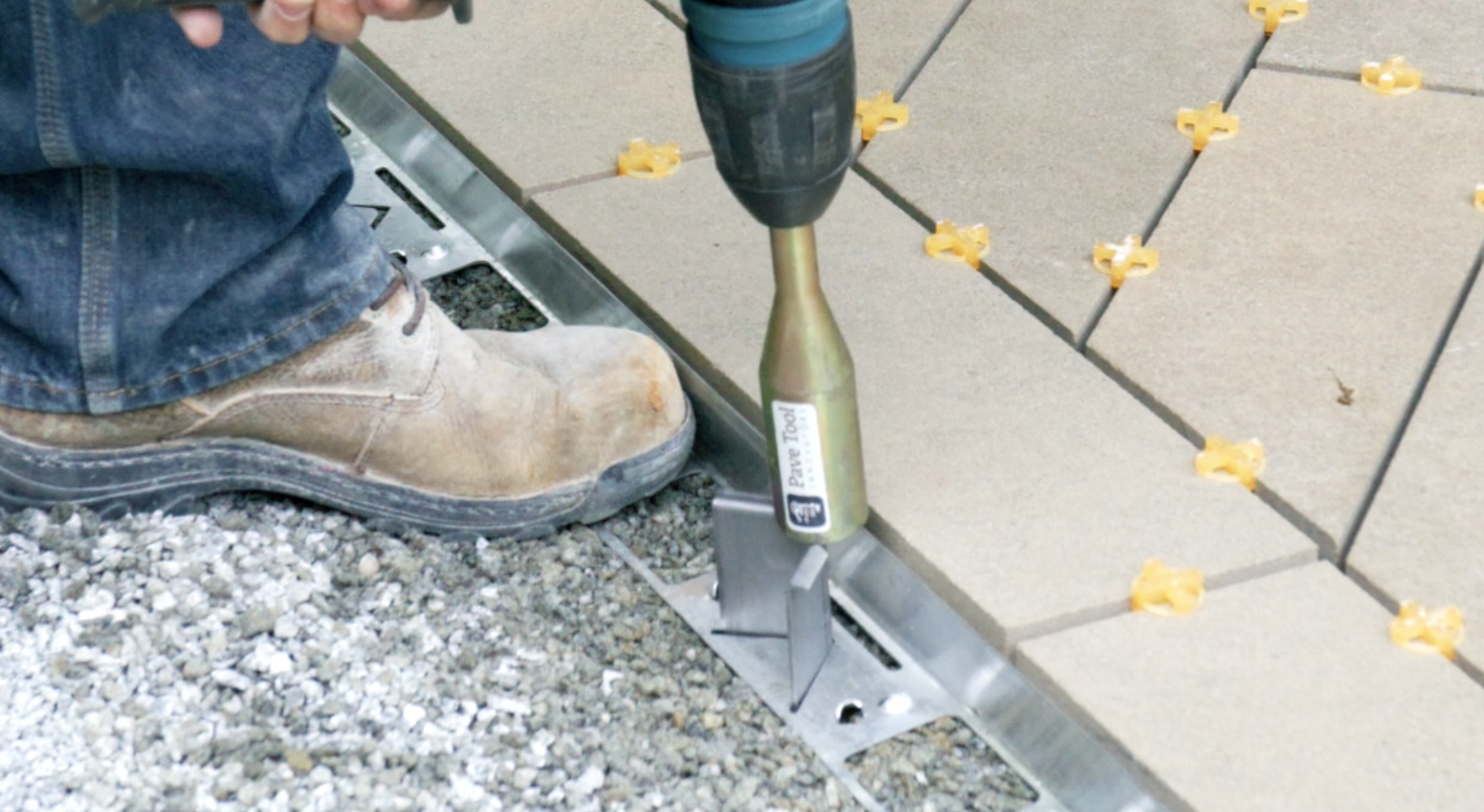
The Quick-E-Hybrid aluminum edging system from Pave Tool is an example of cutting-edge engineering specifically designed for open-graded base paver installation. Its wide base plate distributes loads effectively while large, L-shaped wedge stakes provide superior holding power. Installation requires removing the bedding layer from the paver edge, positioning the aluminum edging tight against the paver side, and using the specialized Quick-E bit chucked into an SDS Max hammer drill to drive the engineered stakes vertically into place.
Specialized Metal Paver Restraint Systems
Natural stone pavers typically measure 1¼ to 1½ inches in thickness, considerably thinner than most precast pavers that are 4”. This dimensional difference makes low-profile edge restraints the preferred choice for natural stone installations, ensuring clean lines without visible lippage above the finished surface. Otherwise, if using taller edging, it would need to be installed deeper in the compacted base to make the paver surface slightly higher than the top of the edging.
For dense-graded base applications, ⅝-inch low-profile aluminum edging by Techniseal offers another excellent metal option. Simply butt the edging against the paver and drive 10-inch spiral landscape spikes into the compacted base for solid, invisible edge restraint that maintains clean sight lines and a strong restraint.
Metal Edging Advantages
The durability of quality aluminum edging systems ensures decades of reliable performance without corrosion or degradation. Unlike steel alternatives that rust over time, aluminum does not oxidize or rust and maintains its structural integrity indefinitely. Paver metal edging also provides the precise control needed for geometric patterns and formal designs where straight lines and sharp corners are essential.
Plastic Paver Edging: Flexibility and Economy
Plastic edging solutions provide economical alternatives that excel in specific applications, particularly where flexibility and ease of installation take priority over maximum structural support. Understanding where plastic edging works best—and where it doesn’t—helps you make informed decisions for your project.
Ideal Applications for Plastic Edging
The flexible nature of plastic edge restraints makes it perfect for curved or flowing pathways where rigid materials would require complex fabrication or multiple joints. Creating smooth curves becomes simple—just cut the connector ties between triangular angles to form the edging to any radius your design requires.
Modern polypropylene materials offer impressive durability characteristics, including corrosion resistance, rust immunity, and UV protection against sun damage. These properties ensure plastic edging maintains its integrity and appearance through years of weather exposure.
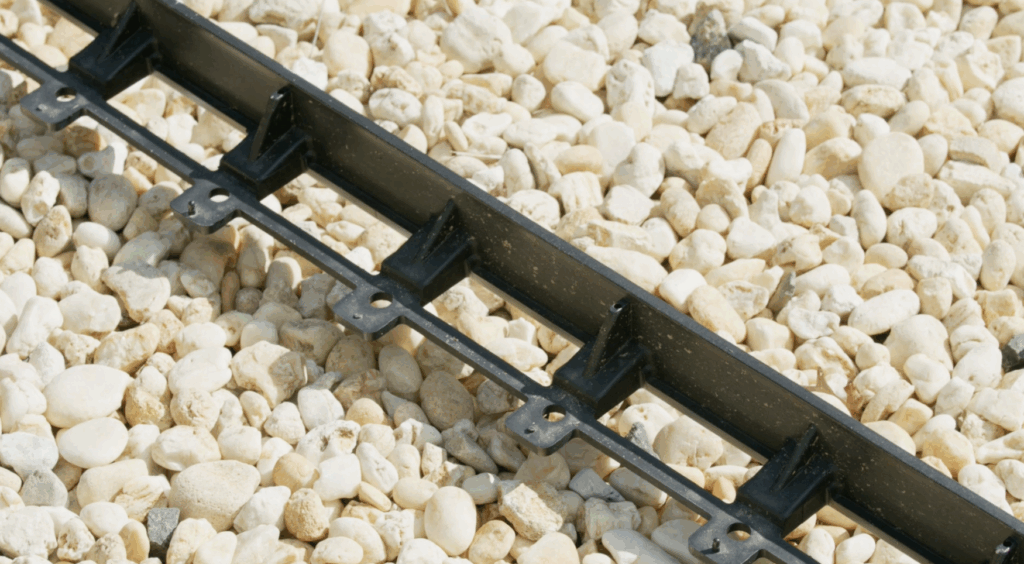
Understanding Paver Restraint Limitations
While plastic edging provides excellent value for appropriate applications, it has important limitations that must be considered. Most standard types will not provide sufficient support for open-grade applications, especially when used with heavier, large-format stone pavers that need additional reinforcement. The reduced structural support of lesser quality paver edging can allow shifting over time, particularly in freeze-thaw climates where ground movement stresses the restraint system.
Plastic edging works best with dense-graded bases and smaller format pavers where the loads remain within the material’s structural capabilities. For these applications, it provides reliable performance at an economical cost.
Perma-Edge: Innovation in Concrete Technology
Perma-edge represents the latest advancement in edging technology, combining the benefits of concrete durability with engineered flexibility and permeability. This fiber-reinforced, polymer-modified concrete product addresses many traditional concrete limitations while providing superior performance characteristics – all contained in one bucket.
Advanced Material Properties
Traditional concrete edging suffers from rigidity that leads to cracking and permeability issues that lead to freeze-thaw damage. Perma-edge is engineered to address both concerns through a specialized formulation that creates material over 700% more flexible and over 40% more permeable than ordinary concrete.
The non-porous aggregate composition prevents water infiltration into the product base, effectively combating freeze-thaw cycles that destroy conventional concrete edging in cold climates. This moisture resistance ensures reliable performance regardless of climate conditions.
Installation Versatility
Perma-edge wet paver edging works equally well with both open-grade and dense-grade base applications, making it compatible with a variety of paving systems. Its flexibility allows the edging to float and flex with sub-base movement, making it ideal for challenging locations with grade changes or unstable soil conditions.
The ability to maintain a low-profile by troweling the product helps keep it below soil, grass, or mulch grade, eliminating trip hazards and eliminating exposed paver edges. This creates cleaner sight lines than traditional spike-and-bracket systems while providing superior holding power.
Installation Technique
Proper installation begins with mixing the product according to manufacturer’s specifications using a paddle mixer for consistent results. Using a trowel, place generous amounts of mixed product against the paver edge while carefully avoiding the finished surface. Compress the material into place with a trowel and use long strokes with a float to create an even profile, maintaining a downward slope away from the paver edge for drainage.
Keep the top edge of the product approximately ½ inch below the finished paver surface to allow space for backfilling and sod installation. This technique creates an invisible edge restraint that provides maximum holding power while maintaining clean aesthetic lines.
Choosing the Right Edging for Your Project
Selecting the optimal edging system requires evaluating several key factors that influence performance and longevity in your specific application.
Application Type Considerations
- Straight-line installations with geometric patterns benefit most from metal edging systems that provide rigid support and precise alignment without bowing. The structural properties of aluminum systems ensure corners remain sharp and lines stay straight through decades of use.
- Curved pathway projects often work best with flexible plastic edging that adapts easily to flowing designs. The ability to cut connector ties and form smooth curves makes plastic ideal for organic, naturalistic installations and winding walkways.
- Open-grade base systems require the superior holding power of metal edging or the engineered flexibility of Perma-edge. Standard plastic edging lacks sufficient structural support for these demanding applications.
Budget and Value Considerations
While initial cost often influences decisions, long-term value requires considering replacement and maintenance costs over the installation’s lifetime. Premium edging systems that cost more initially provide better value through extended service life and reduced maintenance requirements.
Factor in the cost of potential repairs if inadequate edging allows paver movement. Quality edge restraint represents insurance against expensive future problems while preserving your investment’s appearance and functionality.
How to install paver edging: Best Practices
Regardless of which edging system you choose, proper installation techniques ensure optimal performance and longevity.
Pre-Installation Preparation
Gather all necessary tools and materials before beginning work, including edging strips, stakes, shovels, levels, string lines, and appropriate safety equipment. Verify that base materials are properly compacted and meet specifications for your chosen edging system.
Create detailed installation plans with accurate measurements to prevent material shortages or installation errors. Double-check all dimensions and layout details before beginning permanent installation.
Quality Control Measures
Maintain consistent installation depth and alignment throughout the project using string lines or laser levels for reference. Check that stakes penetrate adequately into base materials and that connections between edging sections remain secure.
For concrete-based products like Perma-edge, ensure proper mixing and application techniques to achieve specified performance characteristics. Follow manufacturer’s curing recommendations to develop full strength and flexibility.
Long-Term Performance and Maintenance
Quality edging systems require minimal maintenance when properly installed, but periodic inspection helps identify potential issues before they become serious problems.
- Metal systems should be checked for stake loosening, particularly after severe weather or ground freeze-thaw cycles. Aluminum products typically require no maintenance beyond occasional cleaning.
- Plastic edging may need stake adjustment over time as materials expand and contract with temperature changes. UV-resistant formulations minimize degradation, but older installations may require replacement after many years.
- Perma-edge installations generally require no maintenance once properly cured, but extreme ground movement may require minor repairs using additional product.
Making the Right Choice
Your edging selection significantly impacts both immediate installation success and long-term performance of your paver project. Metal edging provides the rigid support needed for formal designs and demanding applications. Plastic edging offers economical flexibility for curved installations with moderate structural requirements. Perma-edge combines concrete durability with engineered flexibility for challenging applications.
Consider your specific project requirements, including base type, paver format, design geometry, climate conditions, and budget constraints. The right edging system keeps your beautiful natural stone pavers locked in position while maintaining the clean lines and precise alignment that define quality hardscape installations.
Ready to ensure your paver project stays beautiful for decades? Choose the edging system that matches your specific requirements and install it with the care that quality materials deserve. Your attention to this crucial detail will be rewarded with years of trouble-free performance and lasting beauty.
Contact a Polycor expert today to discuss which natural stone pavers and edging systems work best for your specific project requirements. Professional guidance ensures you make the right choices for both immediate success and long-term satisfaction with your hardscape investment.
